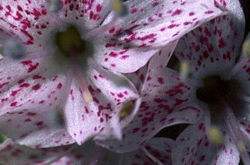Ipomopsis Phylogenetics
Verne Grant pioneered early classification and systematics of the Polemoniaeae. His 1956 paper “A synopsis of Ipomopsis” is a good starting point for learning about the diversity of the group.
Grant, V. 1956. A synopsis of Ipomopsis. El. Aliso 3: 351-362.
Briefly, Ipomopsis is a genus of summer-blooming herbaceous plants with ~ 29 species distributed across North and Central American. Grant originally recognized several “sections” within the genus including Phloganthia (often woody spreading perennials), Microgilia (small herbaceous plants, with small white flowers, often above treeline), and Ipomopsis (tall herbaceous plants with large tubular flowers). Despite widespread interest, to date there is no comprehensive molecular phylogeny of the genus. We have sequenced the internal transcribed spacer (ITS), external transcribed spacer (ETS), and the trnL-F chloroplast intron for many species in the genus. A graduate student at UT, Alan Lemmon, has been helping with some MrBayes analyses of this data. Preliminary trees are presented here [ITS phylogeny; ETS phylogeny; trnL-F phylogeny] as 50% majority rule consensus topologies - these trees should only be taken as starting place for understanding evolutionary relationships in the genus. A number of nodes are strongly supported from these analyses. In general, three major groupings are supported, that, for the most part coincide with V. Grant’s initial section designation. Several of the nodes are unresolved, especially in the Ipomopsis group. It is likely that both ancient and recent hybridization has been an important phenomenon in the group. J. Mark Porter (Rancho Santa Ana Botanical Garden) has sequenced these and several additional nuclear genes from a comprehensive set of Ipomopsis species. We are currently developing a large number of “intron” spanning loci from Ipomopsis EST sequences. We anticipate that a larger sampling of nuclear genes will result in a more completely resolved phylogeny in the near future.
Here is a current species list as recognized in Porter and Johnson (2000).
Porter, J. M. and L. A. Johnson. 2000. A phylogenetic classification of Polemoniaceae. Aliso 19: 55-91.
Click on names to see a representative photo or drawing (many of these photos have been downloaded directly from the web – when possible, I’ve acknowledged photographers). When possible, I've included species distribution maps obtained from the USDA Plant database.
Systematic and Taxonomic Papers
Grant, V. and K. Grant. 1965. Flower pollination in the Phlox family. Columbia University Press, New York and London.
Grant, V. and D.H. Wilken. 1986. Taxonomy of the Ipomopsis aggregata group (Polemoniaceae) Botanical Gazette 147: 359-371.
Wilken, D. and R.L. Hartman. 1991. A revision of the Ipomopsis spicata complex (Polemoniaceae) Systematic Botany 16: 143-161.
Wolf, P.G. 1990. Molecular studies of incipient speciation in the Ipomopsis aggregata complex (Polemoniaceae). P.h.D dissertation, Washington State University, Pullman.
Wolf, P.G., Soltis, P.S., and D.E. Soltis. 1991. Genetic relationships and patterns of allozyme divergence in the Ipomopsis aggregata complex and related species (Polemoniaceae). American Journal of Botany 78: 515-526.
Wolf, P.G and P.S. Soltis. 1992. Estimates of gene flow among populations, geographic races, and species in the Ipomopsis aggregata complex. Genetics 132: 639-647.
Wolf, P.G., Soltis, P.S., and D.E. Soltis. 1993. Phylogenetic significance of chloroplast DNA restriction site variation in the Ipomopsis aggregata complex and related species (Polemoniaceae). Systematic Botany 18: 652-662.


